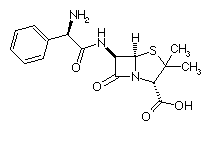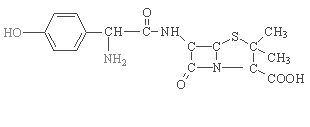|
Description: 6-aminopenicillanic acid |
Penicillins are beta-lactam antibiotics derived from 6-aminopenicillanic acid. The natural penicillins include sodium and potassium salts of benzyl penicillins. Semisynthetic penicillins possess properties that improve upon deficiencies of natural penicillins, including wider antimicrobial spectrum and decreased susceptibility to degradation by gastric acids and beta-lactamase enzymes.
|
||||||||||||||||||||||||||||||||||||||||||||||
|
Mechanism of action:
|
Beta-lactam antibiotics lyse bacteria by binding to cytoplasmatic membrane enzymes (penicillin-binding proteins). This inhibits a step in peptidoglican synthesis that is crucial for cell wall formation. All members of the family have a beta-lactam ring and a carboxyl group resulting in similarities in the pharmacokinetics and mechanism of action of the group members.
|
||||||||||||||||||||||||||||||||||||||||||||||
| Indications: |
Omphalitis; Clostridial infections (necrotic enteritis, ulcerative enteritis, gangrenous dermatitis), Staphilococcosis, Pasteurellosis, Ornithobacterium rhinotracheale, intestinal spirochetosis, Erysipelas.
|
||||||||||||||||||||||||||||||||||||||||||||||
|
Dosage: |
|||||||||||||||||||||||||||||||||||||||||||||||
|
|||||||||||||||||||||||||||||||||||||||||||||||
| Drug interactions: |
Penicillins+Aminoglycosides: There is an in vitro interction between aminoglycoside antibiotics and penicillins leading to a significant loss of aminoglycoside antibacterial activity if these antibiotics are mixed in the same bottle. The extend of inactivation depends on the penicillin concentration, the contact time, and the temperature. Aminoglycosides should not be mixed with penicillins or cephalosporines in the same bottle. In vitro, penicillins interact chemically with the aminoglycoside antibacterials to form biologically inactive amides by a reaction between the amino groups on the aminoglycosides and the beta-lactam ring on the penicillins. Thus both antibacterials are inactivated. Penicillins+Tetracyclines: The generally accepted explanation is that bactericides, such as penicillin which inhibits bacterial cell wall synthesis, require cells to be actively growing and dividing to be maximally effective, a situation that will not occur in the presence of bacteriostatic antibacterials such as the tetracyclines.
|
||||||||||||||||||||||||||||||||||||||||||||||
| Toxicity: |
Generally low toxicity. All penicillins have low toxicity in the normal sense of the word.
|
||||||||||||||||||||||||||||||||||||||||||||||
| Pharmacokinetics: | |||||||||||||||||||||||||||||||||||||||||||||||
| AMPICILLIN | |||||||||||||||||||||||||||||||||||||||||||||||
 |
|||||||||||||||||||||||||||||||||||||||||||||||
|
|||||||||||||||||||||||||||||||||||||||||||||||
|
|||||||||||||||||||||||||||||||||||||||||||||||
| Ampicillin 1 g ≅ 1.06 Ampicillin sodium |
|||||||||||||||||||||||||||||||||||||||||||||||
| AMOXYCILLIN | |||||||||||||||||||||||||||||||||||||||||||||||
|
|||||||||||||||||||||||||||||||||||||||||||||||
| Ampicillin: |
Is a broad-spectrum semisynthetic antibiotic inactivated by beta-lactamases. It is relatively stable in gastric acid secretion and well absorbed from the gastrointestinal tract.
|
||||||||||||||||||||||||||||||||||||||||||||||
| Amoxicillin: |
Is a semisynthetic derivative of penicillin and an analog of ampicillin that displays a broad spectrum of antibacterial activity (bactericidal) against many gram-positive and gram-negative organisms, inactivated by beta-lactamases. Amoxicillin is absorbed better and has more rapid action and greater resistance to the gastric acid than ampicillin. Amoxicillin is stable in the presence of gastric acid and is a drug of choice within the class because of better oral bioavailability.
|
||||||||||||||||||||||||||||||||||||||||||||||
| Residues: |
When amoxicillin was administered orally to broilers for 5 consecutive days, no significant differences were observed between the elimination profiles in healthy and diseased birds. The daily administration of amoxicillin to laying hens at a dosage of 16 mg/kg bw for 5 consecutive days was not found capable of resulting in residues in eggs at concentrations above 0.007 ppm.
|
||||||||||||||||||||||||||||||||||||||||||||||
| Comments: |
Beta-lactamases are enzymes that hydrolyze beta-lactam ring thereby inactivating the drug. |
||||||||||||||||||||||||||||||||||||||||||||||







